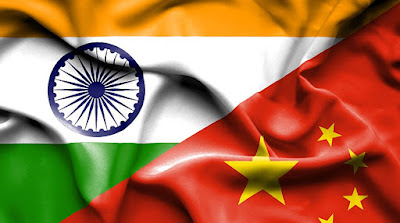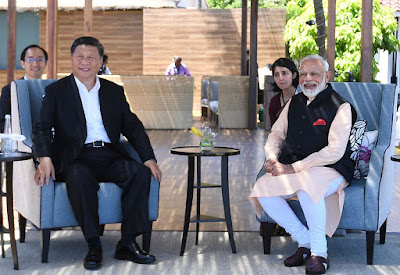India and China's Rivalry
India and China share a border quite 3,440km (2,100 miles) long and have overlapping territorial claims. Their border patrols often encounter one another , leading to occasional scuffles but each side insist no bullet has been fired in four decades.
India's top defence establishment authorities are holding strategic meetings, each day after a minimum of 20 Indian Army personnel including a colonel were killed during a fierce clash with Chinese troops in the Galwan Valley in eastern Ladakh on Monday night.
The latest conflict is that the biggest confrontation between the Indian Army and China's People's Liberation Army (PLA) since their 1967 clashes in Nathu La when India lost around 80 soldiers while over 300 Chinese army personnel were killed within the confrontation.
Reports from various sources indicates that the Chinese side too suffered significant casualties, including the commandant of the unit killed within the confrontation.
India & China, - have the world's largest armies - come face to face at many points. The poorly demarcated Line of Actual Control (LAC) separates the 2 sides.
Rivers, lakes and snowcaps mean the road separating soldiers can shift and they often compared to confrontation.
In this regard Mr Shukla says, "The peaceful Galwan River has now become a hotspot for both the countries because this is the place where the LAC is closer to the new road which India has built alongside Shyok River to Daulet Beg Oldi (DBO) - the foremost remarkable area along the LAC in Ladakh,"
In this regard Mr Shukla says, "The peaceful Galwan River has now become a hotspot for both the countries because this is the place where the LAC is closer to the new road which India has built alongside Shyok River to Daulet Beg Oldi (DBO) - the foremost remarkable area along the LAC in Ladakh,"
India's decision to build up infrastructure seems to possess infuriated Beijing. Chinese state-run media outlet Global Times said categorically that the Galwan Valley region is mainly in Chinese territory, so therefore the local border control situation was very clear."
Worst Clash in Decades --
The incident now increasing tensions between the two countries, and it is the first deadly clash in the border area in last 45 years. The external affairs ministry of India accused China for breaking an agreement struck the previous week to respect the road of Actual Control (LAC) in the Galwan Valley.
BBC diplomatic correspondent James Robbins says violence between two armies high within the Himalayas is extremely serious, and pressure will grow on the 2 nuclear powers to not allow a slide into full-scale conflict.
The current military tension isn't limited to Ladakh. Soldiers from the 2 sides also are eyeball-to-eyeball in Nathu La, on the border between China and therefore the north-eastern Indian state of Sikkim.
Tensions are Rising Between the Neighbours--
The armies of the world's two most populous nations are locked during a tense face-off high within the Himalayas, which has the potential to escalate as they seek to further their strategic goals. The situation is serious.
The Chinese have an inherit territory which they already accepted as a part of India. It has completely changed the established order ," says Ajai Shukla, an Indian military expert who served as a colonel in the army.
China takes a special view, saying it's India which has changed facts on the bottom . Zhao Lijian, a Chinese foreign ministry spokesman said that it was India who had crossed the border twice on Monday, and provoking and attacking Chinese personnel which leads to a serious physical confrontation between the border forces on the two sides", AFP news agency reported.
As well as China's People's Liberation Army (PLA) released a press release on Tuesday night calling on the Indian army to right away stop what it described as "provocative actions" and asked to resolve the matter through proper dialogue and talks.
"The sovereignty of the Galwan Valley region belonged to China only, " Zhang Shuili, the spokesman of the Western Theater said in China's Ministry of Defense website.
It was also added that Indian troops violated their commitment, crossed the borderline for some illegal activities and deliberately launched provocative attacks."
Military and political analysts says that both countries donot need a further escalation — particularly India, where military forces are not as much powerful as China’s military — but they may struggle to seek out how out of the conflict that doesn't hint at back down.
Both countries and their nationalist leaders, President Xi Jinping of China and Prime Minister Narendra Modi of India, have taken increasingly assertive postures that pose real risks of the conflict spinning out of control.
Image source: instagram
“Neither PM Modi or President Xi need a war, but neither can relinquish their territorial claims either,” said Ashley J. Tellis, a senior fellow at the Carnegie Endowment for International Peace in Washington.
At first, India’s military said that only three Indian troops had been killed in the clash, where the Ladakh region of India, the Aksai Chin, a neighborhood area controlled by the Chinese but claimed by both countries.
But on Tuesday night, an Indian military spokesman said that 17 other Indian soldiers had also succumbed to injuries sustained in the clash, raised the number of death to twenty .
Later on an Indian commander said that dozens of soldiers were still missing, apparently they are captured by the Chinese army.
Indian television channels also reported that many Chinese soldiers had been killed in the clash, as well as citing high-level Indian government sources the Chinese officials did not commented on that yet.
It’s not clear what India can do now. But India is in no shape to risk a war against China — especially now, because it slips deeper into the economic and health crisis caused by the coronavirus, which has cost the country quite 100 million jobs.
It’s difficult to understand the precise trigger or severity of the fighting. The Galwan Valley may be a rocky, icy, inhospitable slice of the Himalayas, off-limits to all or any but a couple of lonely herdsmen and Indian and Chinese troops.
But both countries run patrols along the disputed border and therefore the soldiers are under strict orders to not shoot but that doesn’t stop them from throwing rocks. Or fighting with crude weapons.
Many analysts says the Aksai Chin issue, along side India’s warming relations with the us , became irritants to China, which can now be using its military to harass India as payback.
A retired Indian general Singh said that a part of the matter is that the de facto border, the LAC, is so ill defined.
Indian Army General Singh has also said that on a strategic and operational level, both militaries have already exercised restraint. However, at the tactical level, face-offs occur thanks to differ the perceptions of where the particular border is. Because the LAC isn't delineated on the bottom . While face-off gets resolved locally, those associated with the building of infrastructure, invariably take longer and need a mixture of military and diplomatic initiatives to resolve the issue."
History already holds a difficult lessons for India because India suffered a humiliating defeat during the 1962 border conflict with China.
India says China occupies 38,000km of its territory. Several rounds of talks within the last three decades have did not resolve the boundary issues.
China already controling the Aksai Chin area as well as east of Ladakh and this region, which was claimed by India, is strategically important for Beijing because it connects its Xinjiang province with western Tibet.
In 2017 India and China were engaged during a similar stand-off lasting quite two months in Doklam plateau, a tri-junction between India, China and Bhutan.
Conclusion--
Overall China and India were committed to resolving their differences through dialogue, but again, it wasn’t clear if the military commanders along the border were standing down or gearing up.
But several neighbour countries of India, like Nepal and Sri Lanka , that were once reliable Indian allies have recently tilted towards China, wooed by Chinese investment and Pakistan, India’s archenemy, is now fully aligned with China, working hand in hand with the Chinese military.
_Thank You_















0 Comments
(Please do not enter any spam link in the comment box)